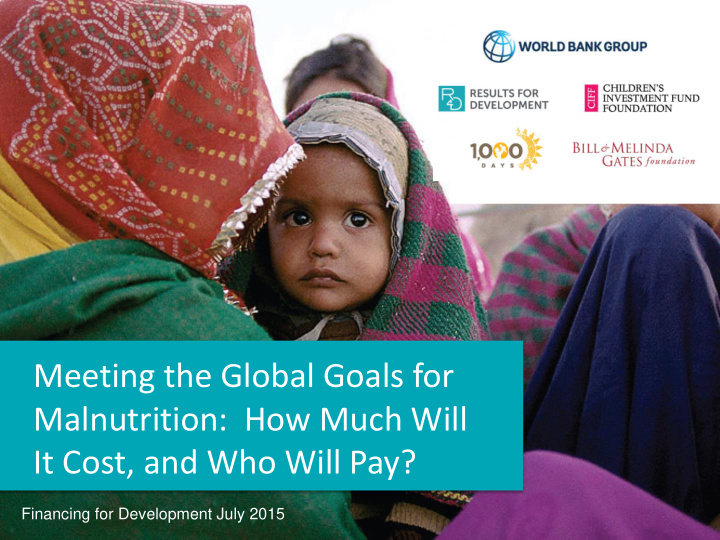



Meeting the Global Goals for Malnutrition: How Much Will It Cost, and Who Will Pay? Financing for Development July 2015
162 million children stunted in 2013 Global target: reduce to ~ 100 million by 2025 Stunting Prevalence: 20 -30% 30-40% >40% 85% of stunting concentrated in 37 countries 2
Investments in nutrition build human capital and boost shared prosperity EARNINGS SCHOOLING POVERTY ECONOMY Early Children who Early nutrition Reductions in escape stunting nutrition programs can stunting can are 33% more programs can increase school increase GDP likely to escape raise adult completion by by 4-11% poverty as wages by 5- one year in Asia & adults 50% Africa 3
The 1,000 day window of opportunity • The first 1,000 days between pregnancy and a child’s 2 nd birthday sets WELL-NOURISHED the life-long foundation BRAIN CELLS for human capital • Adequate nutrition in this 1000-day window is imperative UNDERNOURISHED • If not, the damage to BRAIN CELLS future human capital is irreversible 4
An affordable package of ANNUAL interventions to reduce stunting ADDITIONAL COST PER CHILD UNDER-5 • Improving nutrition for women during $8.50 pregnancy • Improving infant and young child $42 billion additional feeding practices, including exclusive financing for 37 breastfeeding for the first six months highest burden • Improving child nutrition, including countries over 10 years micronutrient supplementation $49.6 billion • Improving policy coordination, additional capacity and evaluation financing globally over ten years 5
Cost and impact on child stunting 162m stunted Underlying determinants ~ 74 million of stunting* fewer children Nutrition-specific stunted interventions in 2025 ~100m stunted by 40% by 2025 $1 invested in stunting = ~ $18 economic returns $15.6 billion required for 2016-2020 $34.0 billion required for 2021-2025 Total $49.6 billion over ten years * Includes per capita GDP, food availability and diversity, and women’s education, health and empowerment 6
Current spending on stunting is drastically inadequate Annual expenditures (USD billions), 2014 2.9 Invested by 37 governments Domestic 1.6 External contributions Donor 0.2 Out of pocket spending Households 1.1 Financing for stunting prevention will have to triple to $9 billion a year in 2025, if we are to achieve the global goal 7
Business as Usual would result in a shortfall of $27 billion, condemning 40 million children to avoidable stunting in 2025 Maintenance 9.0 8.9 8.8 Scale-up 8.7 8.6 7.5 3.4 3.5 3.6 Resource gap remains 6.5 3.7 3.8 5.6 3.1 2.3 Increases 1.0 4.6 0.9 due to 0.8 1.7 0.7 0.6 1.0 GDP 0.5 3.8 1.4 1.3 1.2 1.1 0.9 growth 0.8 0.6 0.3 alone 2.9 2.9 2.9 2.9 2.9 2.9 2.9 2.9 2.9 2.9 2.9 2015 2016 2017 2018 2019 2020 2021 2022 2023 2024 2025 2026 Remaining gap Additional household Additional domestic Additional donor Baseline 8
“Global Solidarity” could generate the resources to achieve the global stunting reduction target Donors and countries share remaining gap in proportion to income Maintenance phase Scale-up phase 9.0 8.9 8.8 8.7 8.6 0.4 1.0 0.9 Countries increase 0.8 7.5 0.7 0.6 spending to income 6.5 0.5 group medians 2.0 2.3 2.7 3.0 5.6 3.3 1.6 1.2 4.6 0.9 2.6 3.8 2.3 0.6 2.1 2.0 1.7 1.6 1.3 1.0 0.8 2.9 2.9 2.9 2.9 2.9 2.9 2.9 2.9 2.9 2.9 2.9 2015 2016 2017 2018 2019 2020 2021 2022 2023 2024 2025 Innovative sources Additional household Additional domestic Additional donor Baseline 9
The global resource mobilization challenge to tackle child stunting is large but achievable Additional resources needed, 2016-2025 High-burden countries (n=37) 42.2 B Remaining LIC and LMICs (n=75) 7.4 B Total to achieve the global 49.6 B stunting goal Between 2001 and 2011, AIDS spending in low and middle income countries grew from <$1 billion to $15 billion annually – a larger amount of incremental spending and a higher rate of growth than what is needed to fight stunting 10
What will it take to reach this goal? POLITICAL RESOURCE WIDESPREAD MONITORING & DECISION ADVOCACY ACCOUNTABILITY MOBILIZATION IMPLEMENTATION MAKING Leaders Prioritizing Unlocking Accelerating Making All Committing low cost, high extra the pace of Stakeholders to increasing return financing scale-up to Accountable nutrition interventions from achieve the through investments in plans and domestic & stunting goal better budgets external, new by 2025 tracking, & traditional analysis, and sources reporting 11
Recommend
More recommend